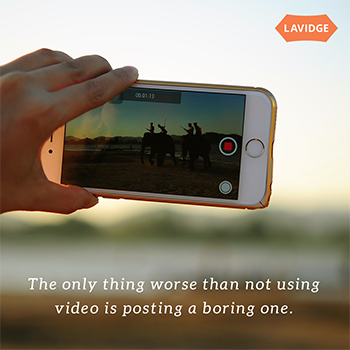Sign up for our LAVY email
and get our bi-monthly newsletter.
There’s a good reason that this article is about marketing restaurants using videos: It works.
If this is an obvious case of giving people what they want, then so be it. Videos have become an entrenched marketing tactic that consumers can’t seem to get enough of. Simply put, video is dominating mobile and social media. Consider the following:
And here’s the kicker stat: 87% of online marketers use video content. The good news for restaurants is that a quality video strategy doesn’t need to cost a fortune. You’re convinced, right?
Here are eight great video ideas to help get your restaurant started.
If you manufacture clothes, it’s important to show off your latest fashion designs. It’s no different for restaurants. We’ve long known that people get hungry when they see pictures or video of delicious food. But the Max Planck Institute of Psychiatry has proven it. Research has shown that when we see images of food, our bodies respond with increased levels of ghrelin, a hormone that controls how we eat and metabolize food. So, don’t be shy about showing your food, from your menu of delectable ice cream cones to honey glazed ribs. Don’t be worried if your food doesn’t look perfect; potential customers like to see the real deal.
Your videos don’t have to be extravagantly staged with Hollywood-grade production values. But you don’t want your restaurant’s hard-earned image tarnished by out-of-focus videos or unprofessional editing. Take the time to get things right. Also, speak with your advertising agency about frequency. You don’t want to post too little or too much—you want customers to see your content on social channels, but not so much that they feel bombarded.
Consumers don’t have patience for long-form video spots. We click the skip button and hesitate playing mobile videos that appear lengthy. Short videos—even those under10 seconds—can work very well for restaurants. A close-up of a plate being set on a table. Someone squirting ketchup on a burger. Stirring a milkshake. On Facebook, where videos play automatically, brief videos work perfectly. By the time someone scrolls past your video they may have already seen the whole thing.
On Facebook, videos start playing automatically. But the sound defaults to off. Some people will choose to hear a video’s sound, but many won’t. Ensure sure your videos don’t rely on the audience hearing music or voices.
Food should be the focus of your videos, but don’t overlook your employees. Consumers enjoy and will engage with behind-the-scenes clips that feature kitchen staff preparing awesome dishes. Better yet, have a chef/cook give a quick list of what’s in a certain dish, or maybe the secret ingredient in a signature meal. 
If you’re willing—and you should be—don’t be afraid to share your recipes, which are among the most shared content online. While you’re at it, encourage customers to share their own recipes and post them to all social media platforms. If you feel your recipes are proprietary, then offer cooking tips or show a meal being prepared without divulging the exact measurements. And if you want, you can say, “Plus a secret ingredient only our chef knows!” It's all about creating relationships with your audience. So have fun with it.
7. Be unique.
This is one of the most difficult elements to get right. The only thing worse than not using video is posting a boring one. Your video content should reflect the essence of your brand and do so in an entertaining way—perhaps with humor or a touch of attitude.
Your customers are a great source for free video content. They’re already posting videos of enjoying themselves at restaurants and showing off beautifully plated meals. Encourage customers to post their videos on your social media platforms, and be sure to take time to search if your restaurant is being tagged online. Sometimes, the videos won’t be flattering, so you’ll want to respond in a constructive way. But most videos are positive, and people enjoy having their content reposted—it demonstrates that you’re willing to engage and listen to your customers.
LAVIDGE has extensive experience in developing video content. Our Phoenix restaurant content studio can create a video marketing strategy customized for your restaurant's needs.
To learn more, give us a call at 480.998.2600 or send email to info@lavidge.com.
If you’re not yet convinced that video is right for your marketing mix, consider the following, courtesy of Hubspot.**

This article is a brief abstract of our exclusive and authoritative study that takes the guesswork out of food service advertising and marketing. Rather than speculating about what will drive consumers to action, we've asked them.
Sign up for our LAVY email
and get our bi-monthly newsletter.